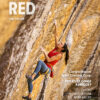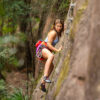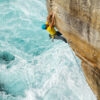Tsaranoro
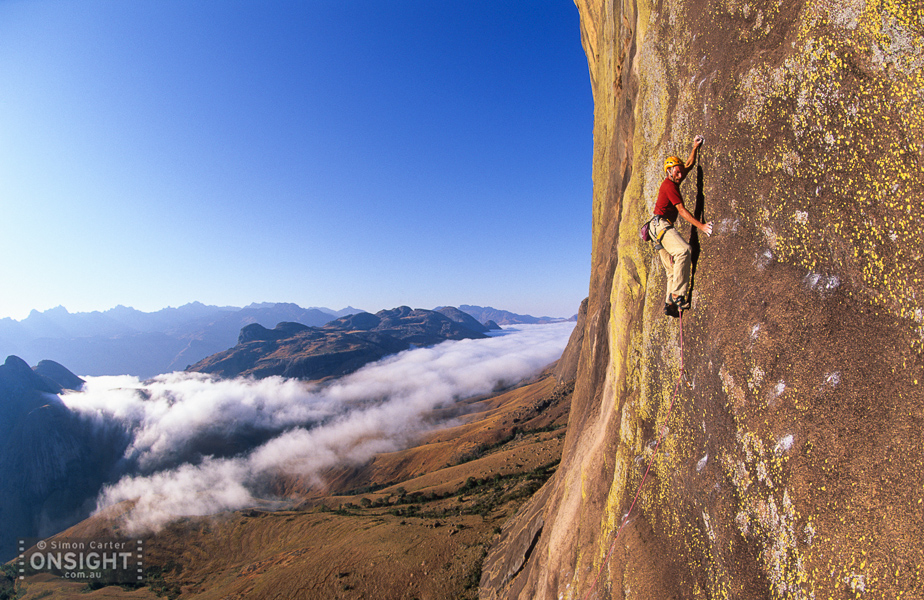 Text by Monique Forestier from World Climbing: Rock Odyssey
Text by Monique Forestier from World Climbing: Rock Odyssey
Madagascar is the kingdom of convoluted place names with so many repetitive syllables they are a mouthful to pronounce. From the capital Antananarivo (Tana for short) it’s a long haul south on Route No. 7, a pulsing vein, the lifeblood of a nation chock-a-block with basket-balancing pedestrians, herds of meandering Zebu and an unwavering stream of dilapidated vehicles which should have been put out of their misery decades ago. Along the way, we pass through the smaller towns of Ambohimandiraso, Antsirabe, Ambalamanakana. The road is lined with shanty housing and market stalls literally thrown together by a sneeze and fastened with good luck. We stop at Fianarantsoa (Fiana) to pick up final supplies before turning onto a goat track for the last leg out to our destination.
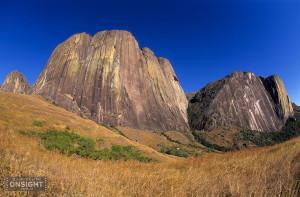 Tsaranoro Massif’s black and orange streaked cliffs, with distinctive sparkling green highlights, forms an imposing crown towering 800 metres above the surrounding plains. The first route, Rain Boto (7b+) was climbed by big wall veterans Kurt Albert and Bernd Arnold in 1995. Today there are over fifty free climbs between 6a and 8c+. The true beauty of this place has got to be multi-pitch moderate (and hard) classics tackling the big walls with superlative quality climbing.
Tsaranoro Massif’s black and orange streaked cliffs, with distinctive sparkling green highlights, forms an imposing crown towering 800 metres above the surrounding plains. The first route, Rain Boto (7b+) was climbed by big wall veterans Kurt Albert and Bernd Arnold in 1995. Today there are over fifty free climbs between 6a and 8c+. The true beauty of this place has got to be multi-pitch moderate (and hard) classics tackling the big walls with superlative quality climbing.
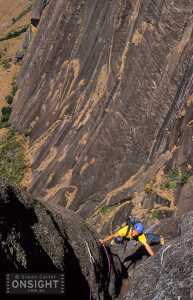 Squatting demurely in the shadow of the Massif, the privately operated Camp Catta is a base camp with a mirage-type feel. Every evening the dining room is abuzz with an international cast of climbers telling tall tales and exchanging route beta. Abba’s “Dancing Queen” plugs any unlikely gaps in the conversations as climbers copy topos for the next day’s escapade.
Squatting demurely in the shadow of the Massif, the privately operated Camp Catta is a base camp with a mirage-type feel. Every evening the dining room is abuzz with an international cast of climbers telling tall tales and exchanging route beta. Abba’s “Dancing Queen” plugs any unlikely gaps in the conversations as climbers copy topos for the next day’s escapade.
To get into the swing of things we select the ten-pitch Cas Nullard (6a) and bridge and smear our way up and over a series of massive runnels, much like changing trains on the subway, a heart-thumping introduction to Tsaranoro. Team Germany, comprised of Toni Lamprecht, Benno Wagner and Felix Frieder, have spent nine days equipping a new route called Manara-Potsiny (8a), bolting all 18 pitches ground-up, on lead, as is the ethic here, a visionary line. Through 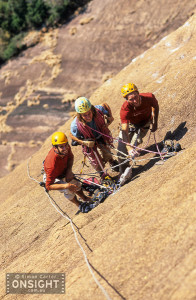 binoculars I watch Team Holland on the 17 pitch Gondwanaland (7c), one of the ultra-classics here. Another four-something-am start, sees Fred Moix and Simon on a mission to do Out of Africa (7a). With 14 sustained pitches blasting its way up the middle of Tsaranoro Be, this route is reason alone to visit this place.
binoculars I watch Team Holland on the 17 pitch Gondwanaland (7c), one of the ultra-classics here. Another four-something-am start, sees Fred Moix and Simon on a mission to do Out of Africa (7a). With 14 sustained pitches blasting its way up the middle of Tsaranoro Be, this route is reason alone to visit this place.
On another flank, on the east face of the Karambony, Team France (Francois Legrand and Greg Sobczak) attempt to free climb the 380-metre Tough Enough (8c+). Certainly the hardest big wall in the southern hemisphere, having ten pitches of highly technical and finger intensive moves up an almost featureless granite wall. It was later free climbed by Adam Ondra in 2010.
On our way out we say goodbye to the endangered Lemur Catta, a pint-sized nutmeg-coloured monkey dwarfed by its zebra-patterned squirrel tail which inhabits the forest near our camp. You’d think these critters were invented by pre-schoolers using spiral flip-books of misplaced animal parts. They are a delight to watch, one of the joys of visiting this crazy place.
Tsaranoro Logistics
Season: April – November
Flights: Fly to Antananarivo (Capital) direct from Bangkok with Air Madagascar, or via Mauritius from Singapore and Hong Kong with Air Mauritius. Alternatively go via Johannesburg and connect with an Air Madagascar or Interair flight to Antananarivo. If coming from the US sometimes flights go via Paris.
Read more: http://www.lonelyplanet.com/madagascar/transport/getting-there-away#ixzz2wvsr1Gbe
Tsaranoro: The place to stay at Tsaranoro is Camp Catta — www.campcatta.com. Be sure to book transfers and accommodation in advance. To get there from Antananarivo (Tana) it’s at least a full day travel to reach the town of Fianarantsoa (Fiana). Public taxi-brousse operate from Tana’s southern station (Gare Routiere du Sud) or, for a faster more reliable option, arrange a private taxi and settle on a rate before you leave. Contact Eric Mongou on (032.04.320.06 or 034.01.365.48) for a responsible driver. Note that Fiana is the last opportunity to buy supplies, otherwise you are totally reliant on the European-priced meals at the camp. Once you are at the camp you most likely won’t go back to Fiana so buy up big. From Fiana, it’s a three hour drive to Tsaranoro. It’s recommended to transfer with Camp Catta’s 4WD, it’s pricey but convenient and they have an office in Fiana. There are several accommodation options at the camp – stay in your own tent, one of the camp’s tents, bungalows (sleeps up to three people), or one of the mini chalets (sleeps up to 6 people). Either self-cater with food you’ve brought with you or enjoy meals in the camp’s restaurant, which although very expensive are appreciated after a big day on the wall.
Handy hints: Take a French phrase book and the Lonely Planet (LP) guide, it’s an absolute must have. Use the LP to pre book hotels wherever possible as it saves time, money and inconvenience. Visas are required and so too are vaccinations and anti-malaria pills. Don’t forget high voltage bug spray. For the boys, take razor refills and for the girls, tampons as these are not readily available. Forget your laptop, mobile phone and pretty much any hope of keeping in touch with the western world for the duration of your stay. There are ATM’s taking Visa in the larger towns but virtually none accept MasterCard.
Topos: Topos are available on the Camp Catta web site www.campcatta.com/topo2 or flick through the beautifully illustrated folders at the camp.
Equipment: Take two ropes at least 60m (some of the raps are long) and 16 draws (most routes are fully bolted – there are just a few routes with trad gear).

































